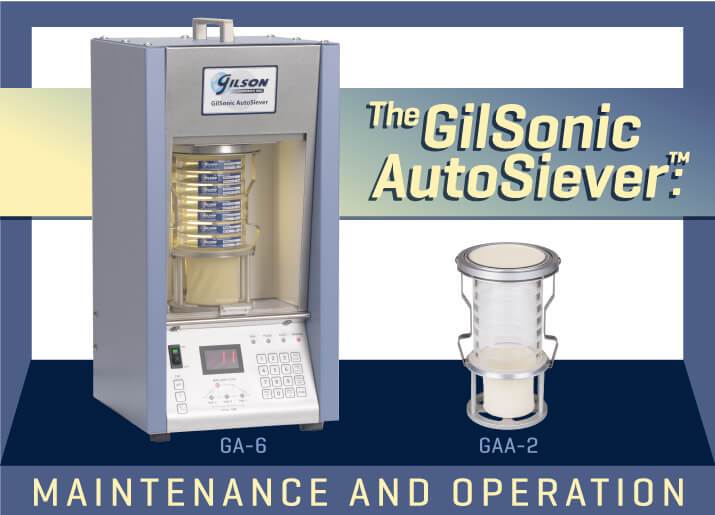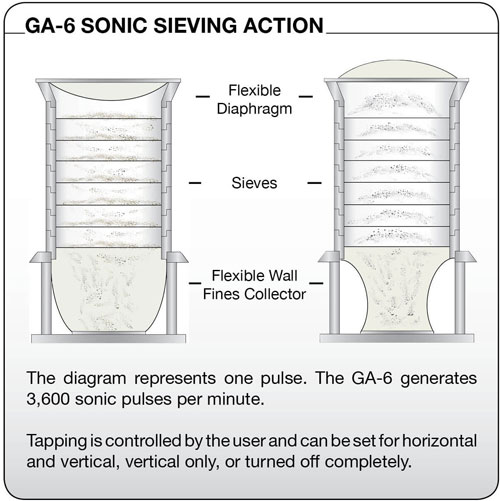
If you use Gilson’s GA-6 GilSonic AutoSiever for particle sizing, you already know it is the ideal solution for hard-to-separate fine powders. Charlie Ward, the inventor of sonic sifting, designed the GilSonic AutoSiever to improve his original production model. The AutoSiever performs highly accurate particle size determinations for small samples of fine powders.
Principles of Sonic Sifting
Sonic sieving directs audio energy pulses to the air column enclosed by a stack of sieves to agitate particles. A flexible diaphragm at the top of the stack and a cylindrical fines collector below stretch with each pulse, maximizing the air movement and ensuring each particle is lifted and reoriented when it lands on the sieve surface.
As explained in this previous Gilson blog post, sonic sieving optimizes the accuracy and repeatability of particle sizing, especially for fragile or sensitive materials or those that resist separation because of moisture or electrostatic attraction issues.
The principles of sonic sifting are the same as conventional sieving, but the unique equipment requires different techniques for use and maintenance. This blog post explores the cleaning, care, and storage of the GA-6 AutoSiever, acrylic test sieves, and latex components, along with some how-to tips for optimizing sonic sieving performance.
Sieves With a View
Two types of 3in (76mm) acrylic frame test sieves are available for use in the AutoSiever. Sieves fitted with ASTM E11 woven-wire cloth are used for many applications and have the same opening sizes and wire diameters as conventional test sieves.
Precision sieves are used for precision sizing of materials down to 5µm or finer and are made with electroformed mesh meeting ASTM E161 standards. Opening size tolerances are ±2µm or less, two to ten times more precise than E11 sieves.

The clear acrylic frames of these sieves allow real-time monitoring of the effects of sample agitation throughout the test cycle, a key factor when optimizing program settings. Each hand-built sieve frame is precisely machined for a close, nested fit that encloses the air column and prevents sample loss.
Note:
|
- ASTM E11 acrylic frame sieves are available with opening sizes from 5.60mm (No. 3½) to 20µm (No. 635) and, as a rule, are more robust than Precision sieves. The frame heights are shorter than precision sieves, allowing up to seven sieves in a stack.
E11 sieves can be carefully cleaned by brushing the underside with the appropriate sieve brushes or in many ultrasonic cleaners using a mild detergent solution. Temperatures above 120°F (49°C) may damage the adhesive bond between the wire cloth and the acrylic frame.
- Precision electroformed sieves are manufactured by the electrodeposition of nickel on planar stainless-steel mesh. Opening sizes from 150µm to 5µm are very precise, and the finer sizes are quite delicate. Avoid touching the mesh with bare fingers during handling. Acids and oils in the skin could cause corrosion of the mesh.
Precision sieves can be cleaned by soaking in a mild detergent solution or in a 3in/8in ultrasonic sieve cleaner designed for use with electroformed sieves with a power output of 150 watts or lower at a temperature not to exceed 90°F (32°C). The sieves should air dry at room temperature after cleaning. Sample loads should not exceed 5g on a single sieve during testing.
- After cleaning and air-drying, each sieve should be visually examined for damage. Check the clear acrylic frame for cracks and confirm that the mesh is still secure in the frame with proper tension. Look closely at the mesh to check for damage, loss of tension, distortion, or an excessive number of blinded (blocked) openings. After the visual checkup, store the sieves in their original plastic cases to prevent damage.
Diaphragm and Fines Collector Care
The diaphragm and fines collector of the sonic sifter are made of flexible latex material deposited on lightweight metal rings. During use, the diaphragm is positioned at the top of the sieve stack and the fines collector at the bottom, closing off a column of air in the sieve stack. The latex surfaces flex at high speed in the sieving chamber when activated by pulses of audio energy, causing vertical oscillation of the captive air and agitating the sample.

The natural latex material is organic and eventually degrades. The shelf life of the parts is around 12 to 18 months when stored properly. How long the latex lasts in use is hard to predict and depends on the number of test cycles, power settings, sample material, and laboratory environment. However, there are some strategies to maximize their useful life.
- Store new diaphragms and fines collectors in their original package in a cool, dark, dry environment. A refrigerator is ideal, but the parts should not be allowed to freeze.
- After each use, wash the pieces gently in a mild detergent solution and air dry thoroughly.
- Lightly dust the latex with cornstarch or talcum powder and use a soft-bristle brush to remove excess powder.
- Return to the original packaging and store in a cool, dry environment.
- For repeated testing of the same sample material, washing is not necessary after every test cycle. Gently brush the components to clean, then store as recommended.
Check the latex material carefully before each use by examining it against a strong backlight. Flaws such as tears, pinholes, or separation of the material reduce sieving accuracy and performance and causes the loss of sample material. Keeping a supply of diaphragms and fines collectors on and hand and following a rotation schedule for use and maintenance cycles minimizes service interruptions.
Optimizing AutoSiever Settings
The unique ability of sonic sifters to separate difficult materials comes from careful adjustments to amplitude and tapping settings. Lower amplitude (power) levels and limited or no tapping action can prevent attrition of fragile sample materials. Increased power and aggressive two-way tapping can effectively sieve samples that resist separation. High power settings should be approached with caution because they may shorten the life of finer precision electroformed sieves.
Operating parameters can be set manually during testing for some materials, but pre-set programs ensure the greatest accuracy and consistency, especially when testing similar samples repeatedly. The AutoSiever has built-in functionality to create automatic ramp/dwell power programs over a wide range and operate with vertical tapping, horizontal tapping, or no tapping at all.
A pre-programmed test cycle is selected and automatically starts with a low-amplitude agitation of the sample that gently separates individual particles. The power ramps up to the experimentally determined maximum over a specified time and dwells there for the test duration. The cycle ends with the power ramping down to allow passage of near-size particles. Tapping configurations are also selected experimentally and programmed into the selected cycle.
Creating a program with the optimum ramp/dwell and amplitude settings for each material is a straightforward process:
- Following instructions in the operating manual, prepare a sample in the sieve stack assembly and secure it in the AutoSiever.
- Power the machine on in manual mode at a low amplitude level.
- Visually observe sample agitation while gradually increasing the amplitude level.
- Amplitude settings are ideal when particles are moving fluidly across the sieve surface and are lifted less than half the height of the sieve frame.
- Tapping action should be limited to promoting the effective passing of material through the mesh. Excess tapping action could damage sensitive materials.
Care of the AutoSiever
The AutoSiever is compact and self-contained. Place it on any level, sturdy, and vibration-free surface for operation, positioned for clear observation of sample agitation during testing.
Clean the sieving chamber periodically with a gentle HEPA vacuum unit with a soft-bristle brush attachment. Wipe down the unit control panel with a damp cloth when power is off.
The sieve stack assembly consists of the sieves, diaphragm, fines collector, and top cone, along with the metal framework that secures the components.
Additional Videos:
- GA-6 GilSonic AutoSiever Sonic Sifter
- GilSonic AutoSiever Controls and Display
- DIY replacement of the AutoSiever sieve chamber lamp
- DIY replacement of the AutoSiever audio speaker
- DIY replacement of the AutoSiever electrical fuse
Testing Resources
Standard Test Methods, Specifications, and Practices
Individual test methods and specifications referenced in our product descriptions, blog articles, and videos are available for review or purchase from the professional organizations noted.
- ASTM International (American Society for Testing and Materials)
- AASHTO (American Association of State Highway and Transportation Officials)
- ACI (American Concrete Institute)
- State DOTs (Departments of Transportation)
- ISO (International Organization for Standardization)
- BS (British Standards)
- EN (European Standards)
















